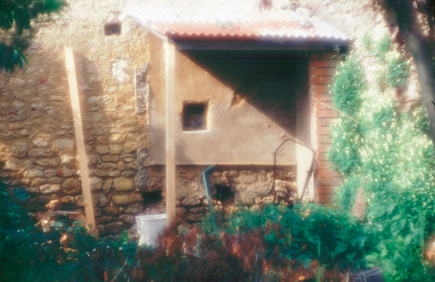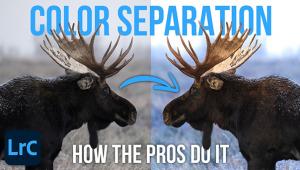The Leitz Thambar 90mm f/2.2
Why Is It Considered A Legendary Portrait Lens? Page 2
The dual aperture range is because the Thambar was supplied with a central
stop: in effect, a clear glass filter with a black spot in the middle, about
13mm (1/2") in diameter. This cuts out the central (sharpest) part of
the image and makes everything even softer.
Without the stop in place, the white scale is used; with it in place, the red
scale. This is why the red scale stops at f/6.3. At this point, the center stop
and the conventional iris diaphragm combine to give roughly zero transmission
of image forming light--though there's so much flare in an uncoated
four-glass lens that a through-lens meter doesn't necessarily realize
this.
The effect of flare on a relatively simple through-lens meter, as found on modern
Leicas and Voigtländers, is not what you would expect. At least, it's
not what I expected. Using a constant diffuse source (a light box) I checked
three lenses on a Leica MP: 90mm f/2.2 Thambar (with center spot), 90mm f/4
Macro-Elmar-M, and a 90mm f/3.5 Voigtländer APO-Lanthar. All gave the same
readings, within experimental error, at all apertures. The same was true with
a Voigtländer Bessa-R, the other camera on which I tried it: the Bessa-R,
of course, is Leica screw fit, unlike the Leica M and Bessa R2.
 |
|
|
These identical readings do not, however, mean that the optimum exposure is
the same for all three lenses, because all the spare light bouncing around in
an uncoated four-glass lens increases the effective shadow exposure spectacularly,
so that the loss of image-forming light as a result of the absence of coating--at
eight surfaces, about a whole stop--is more than made up by the extra non-image-forming
light that still ends up in the shadow area of the film.
This means that, in effect, you can cut exposure by half a stop or even a stop
with many subjects: I found that I got the best results by re-rating Kodak EBX
at ISO 120 or 125 with the through-lens meter in the MP that I was using, though
with a separate handheld incident-light meter (Gossen) I found the ISO speed
worked best. In order to recover the lost contrast and reduced color saturation
you need to give extra development in black and white or use high-saturation
films such as Kodak EBX in color.
The reason for the gap on the white aperture scale, I surmise, is that there's
not much point in using the Thambar without the center spot in this range: the
soft-focus effect will be negligible, but the lens won't be fully sharp,
so it will just behave like an inferior lens. You therefore use it wide-open
without the stop (f/2.2-f/2.6) or with the stop in the f/2.3-f/6.3 range. Incidentally,
the difference between f/2.2 and f/2.4 is just 1/6 stop, and between f/2.2 and
f/2.6 it's only 1/3 stop, so there is some rather unnecessary precision
here.
As for dimensions, handling, etc., the lens is about 97mm (3.8") long
(at infinity) and about 55mm (2.2") in diameter at its widest point, the
aperture ring. It weighs almost exactly 450 g, 1 lb: substantial, but there's
a lot of brass in it, all finished in chrome and black lacquer. The rotating
mount focuses to a bit better than 3 ft, just under 1 meter: the last marked
distance is 3.5 ft, 107cm, but the lens focuses some 40Þ beyond that out
of a total travel of about 350Þ.
The very long focus travel makes focusing accurate but means that the lens is
quite slow to use: the travel between 5 ft and 10 ft, for example, is about
90Þ or 1/4 turn, about the same as the entire focusing travel (infinity
to 1 meter) of the 90mm f/3.5 Voigtländer APO-Lanthar. This lens is scaled
only in feet: it was also available scaled only in meters. The aperture scales
are duplicated so that there is always one scale reasonably visible, but the
apertures are not equally spaced: the distance between f/2.2 and f/2.4 is the
same as the distance between f/9 and f/25 (all on the white scale).
The center stop is a 48mm screw fitting but has no front thread, so special
push-on filters are required if you want to use filters and the stop together--unless
you put the filter behind the center spot, which may lead to exposure anomalies,
though I have to confess I didn't think to try it. The lens was also supplied
with its own unique push-on lens shade, about 33mm deep overall or 25mm to the
front of the center stop. This reverses over the lens for storage, and has its
own 52mm push-on metal Leica lens cap: if either of these or (especially) the
center stop is missing, the value goes down quite smartly.
There's not a lot else to say. Obviously it's not a lens for everyone,
and indeed, until I tried this one, I would have accounted myself among those
who had no need of it. But as I said, I was wrong. There's usually at
least one Thambar for sale somewhere, and when one comes up at a price I can
afford, I'm going to buy one. This shouldn't be a collectors'
lens. It's a lens to use. And it's deservedly a legend.
- Log in or register to post comments

































